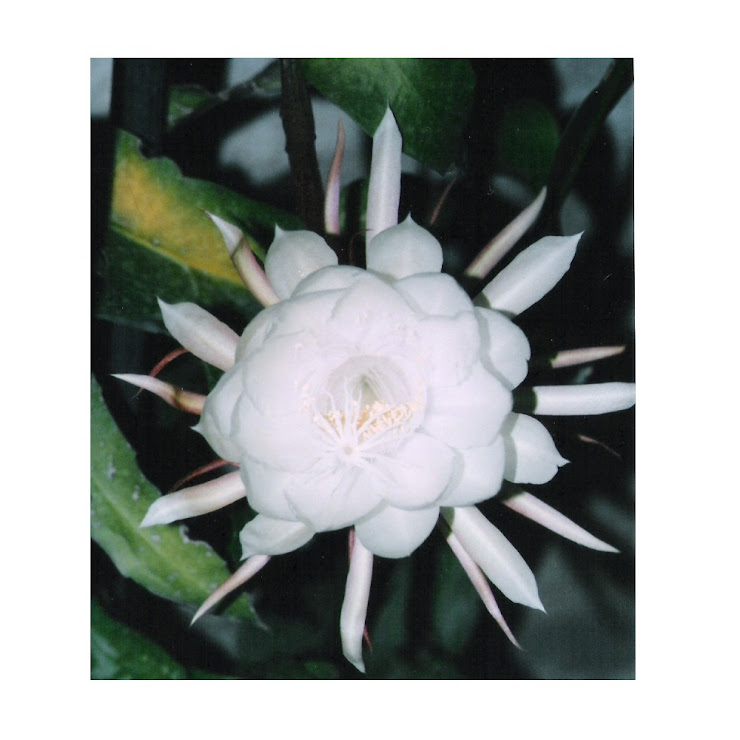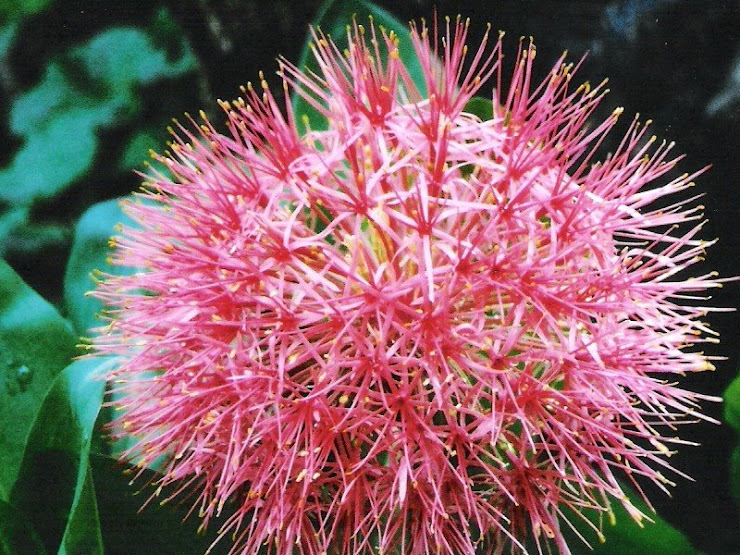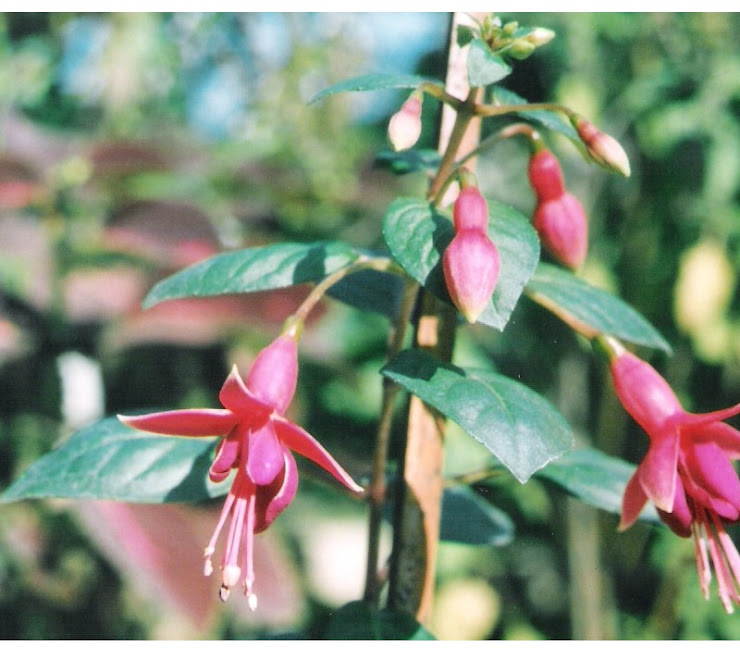CARING FOR CONTAINER PLANTS
With container gardening, nothing is more important than water. Plant roots are not able to search out water on their own. Don't be misled by rainfall; it will not be of much importance in supplying moisture to your container plants.
When watering your plants, always make sure you are reaching the roots. Watering the surface does little good. Apply water until it begins trickling out the bottom. This can be deceiving if the plant is excessively dry, because the water sometimes will run down the sides of the container into the drain holes, not penetrating the rootball. Wet the soil with small successive doses of water until you are sure the rootball is saturated.
Frequency of watering will vary according to weather, size of the plant, and type of container. Try always to water before plants show signs of wilting or stress. In summer, daily watering of container plants is often required. Early morning and evening are the best times to water. Watering in hot summer sun can scorch foliage.
Overhead watering
Watering plants from above with a hose or watering can is the simplest and most common method of watering. Ideally, the water should be applied like a light spring rain with fine gentle droplets. One way to do this with a watering can is to use an attachment called a rose, which breaks the water into fine droplets. This allows water to soak in gradually and minimizes compaction of the soil.
During summer, watering can become very time consuming if you have a number of containers. Plants can be grouped closely, with sprinklers arranged to supply water, although this generally leads to water waste because much of it falls into corners and between plants.
Some plants, especially hairy-leaved ones, scorch easily and should always be watered from the bottom.
Bottom watering
Watering from the bottom can be accomplished by submerging a pot in water, standing the pot on wet matting, or using a wick for capillary watering. The wick must be connected to a reservoir of water and often can be inserted into the container through the drainage hole. Matting and wicks often must be purchased through garden supply catalogs.
Some window boxes have or can be adapted to include a self-watering reservoir. The reservoir is filled from the top or side of the window box and delivers moisture to the plants through a wick. These planters often must be purchased through garden supply and specialty catalogs.
Reviving a wilted plant
You can revive a wilting plant by setting the pot in a tray of moist gravel. If the plant is so dry that the soil has pulled away from the sides of the container, it takes extra effort to rewet it. The best way to do this is to submerge the entire pot in water for a half hour or so. When bubbles stop rising to the top, the rootball is saturated.
If your container is so large that these methods are not practical, wet the soil with small successive doses of water until you are sure the rootball is saturated. If you apply water all at once, it will run down the sides of the pot, missing the rootball entirely, and the plant will continue to suffer.
Fertilizing and Repotting
Seasonal plants such as annual flowers and vegetables will need more feeding than slower-growing containerized trees and shrubs. Annuals grow quickly, exhausting nutrients in the soil. No matter what kind of container plant you have, apply fertilizer only during the growing season.
Liquid fertilizer is easy to use for baskets, window boxes, and smaller containers. Use an all-purpose flower and garden fertilizer. If you are growing mostly flowers and fruiting plants, a fertilizer with a high potash content (for example, a 10-10-27) works well. Seaweed extracts and fish fertilizers are good if you want to use organic fertilizers. You probably will need to fertilize every two or three weeks, but follow the instructions for the specific fertilizer you select.
For larger, permanent container plantings of trees and shrubs, fertilizing should be light, because you don't want the plants to grow so vigorously that they outgrow their containers. Replenish these plants by top-dressing them in spring with an inch or two of new soil. Add a dose of fertilizer at the same time. Controlled-release, polymer-coated granule fertilizers work well for this.
Repotting
To determine whether your plant is rootbound, turn the container upside down or on its side and gently remove the plant. Examine the roots. Unless your plant is large, heavy, and hard to handle, the best time to do this is after watering.
To repot a rootbound plant, prepare a container one size larger than the current one, and fill the new container with soil. Take the plant, still in its old container, and press the plant and container into the new soil and container. Then lift the old container (with plant) out of the new soil, and you will have molded a spot exactly the right size for your plant. Remove the plant from its old container and cut any circling roots from the rootball before planting. Water the plant immediately after repotting.
Repotting trees and shrubs
If you are growing a tree or large shrub in a container, you may reach a point where it's no longer practical to continue moving the plant to larger containers. However, to keep the plant vigorous, you must still repot it when it becomes rootbound—and you must prune the roots at the same time.
To do this, remove the plant from the container. With a pencil, screwdriver, or other sharp instrument, gently remove shards of pottery, rock, and old compacted soil from the rootball. Cut off dead, diseased, or problem roots with a sharp knife. Place the plant in a new container of the same size, or the old container after it has been cleaned and disinfected. Gradually work in new soil mix, watering lightly as you go to distribute the new soil around plant roots.
In spring, top-dress any plant that is not transplanted at least once a year, using an inch or two of soil mix.
Tools for Container Gardening
Container gardening can be done without many specialized tools. However, there are some that will make your work much easier.
Watering can with rose
Watering cans should have a long neck to help you reach pots easily. Large watering cans (more than 1 gallon) are heavy and harder to handle, so their design is important. Some watering cans have long crossbars that make them easier to handle. Look for a good watering can with a rose attachment on the spout so the water is delivered like a soft rain and not a torrential jet. A rose attachment also makes it easy to carry out foliage fertilizing.
Hose nozzles and sprinklers
Water wands are lightweight but sturdy metal or plastic spray wands that attach to hoses. Some are specifically adapted for watering baskets. Nozzle sprinklers have adjustable ranges and can be inserted into one large pot to cover several pots in a larger area.
Sprayer
A small sprayer (about 3 pints) can be used for misting, fertilizing, or applying insecticidal soap and pest deterrents. Sprayers that can be connected to garden hoses also are handy. A sprayer that has held insecticide or pesticides should never be used for anything else.
Pruning knife, shears, or scissors
Whether you need any or all of these depends on what kind of plants you have. If you're growing trees or shrubs, you'll need pruning shears. If you're growing annual flowers, you might need only a good strong scissors and a knife. A garden knife is versatile and works well for root pruning.







No comments:
Post a Comment